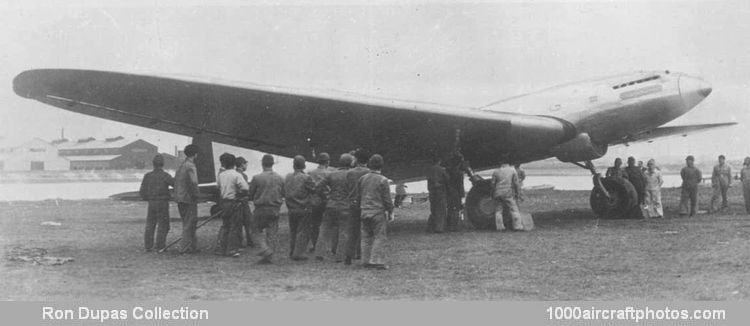03/15/2020. Remarks by
Johan Visschedijk: "During the 1920s and 1930s, aviation records were constantly being set in all categories throughout the world; distance, duration, speed, and altitude. It was appropriate that Japan should make its mark in one or more of these events. In 1931 a plan was initiated by the Aeronautical Research Institute for a flight to achieve the greatest non-stop closed-course distance. Because the Institute retained a close alliance with Tokyo Imperial University, although formally separated from it in 1921, the plan was submitted to the Ministry of Education which led to approval by the Diet (Japan's legislature) for a grant to finance the project.
Study and specifications for the aircraft began in December 1932, with many staff members of the University being involved in the design and engineering of this major undertaking. Committees were formed under skilled leadership for the engineering of specific systems. Heading the project was Dr. Koroku Wada, assisted by the Department Manager of Power plants, Professor Keikichi Tanaka. A stronger incentive for the program while still in the design stage came when the French claimed a new world distance record of 6.587 mls (10,601 km) with the Blériot 110 in March 1932, a distance far short of the projected 8,078 mls (13,000 km) that the Japanese were aiming for.
The most important aspect of the project centered on the airfoil. Those selected had 17.5 percent thickness at the root tapering to 4 percent at the wing tip, having an overall aspect ratio of 8.7. The Koukenki (also noted as Kouken-ki, Kouken, Koken-ki, Koken) was of all-metal construction with fabric covered flying controls and outer wing panels.
The slender fuselage was of semi-monocoque design and had two open cockpits, seating a crew of three in total. These could be faired over flush with the surface to reduce drag while in flight. It was powered by a 700-715 hp Kawasaki twelve-cylinder liquid-cooled V-engine (modified version of the BMW VIII built under license), driving a Sumitomo SW-4 two-bladed metal-covered wooden propeller. Fuel was carried in fourteen tanks within the wing, all interconnected as one system in order to maintain a constant center of gravity. A very advanced feature at that time was a fully-retractable landing gear with sliding fairings, the first of its kind.
Upon completion of the basic design in August 1934, Gasuden (Tokyo Gasu Denki Kogyo KK, Tokyo Gas and Electrical Industry Co. Ltd.) at Omori, Tokyo, was selected as the airframe manufacturer. Construction of the aircraft was slow in starting because final design was not begun until August 1934 and tooling began the following year. Due to new concepts in metal fabrication incorporated into this design and lack of Japanese experience, production was slow and not completed until March 31, 1937. The aircraft was moved to a hangar of the patriotic Kaibo Gikai (Marine Defense Volunteer Foundation) at Haneda Airport, Tokio, on April 8.
The long awaited first flight of the Koukenki finally took place on May 25, 1937, with Major Yuzo Fujita as the pilot. He, and the other two crew members, Master Sergeant Fukujiro Takahashi as copilot, and assistant engineer Chikakichi Sekine as flight engineer, were all from the Army Air Technical Research Institute at Tachikawa. This Army air crew remained fully involved with the project from the start.
Just a month later, between June 17 and 20, 1937, the Russians, in a
Tupolev ANT-25, made their famous first non-stop flight over the North Pole from Moscow to Vancouver in Washington State on the US west coast. The Japanese Koukenki and the Russian ANT-25 were strikingly similar in layout. Although the Russian flight covered 5,288 straight-course miles (8,510 km), the distance planned for the Japanese flight would far exceed this.
On November 13, 1937, the first attempt was made to establish a new distance record, this had to be abandoned due to landing gear problems. A second attempt May 10, 1938, had to be abandoned due to failure of the automatic pilot. Finally, at 04:55 hr on the morning of May 13, 1938, the Koukenki took off from Kisarazu Naval Air Base on the east side of Tokyo Bay to begin its record breaking flight. It was monitored by Navy Lieutenant-Commander Tomokazu Kajiki who was the FAI's representative in Japan.
The route was a four-sided course of 249.641 mls (401.759 km) from Kisarazu to Choshi, Ohta, Hiratsuka and back to Kisarazu. After 29 laps, the aircraft landed at Kisarazu at 19:21 hr after establishing a closed-course record of 7,239.58 mls (11,651.011 km).This record stood for fifteen months but was broken by an Italian Savoia-Marchetti SM.82 in August 1939 with 8,038 mls (12,936 km) flown. However, the Koukenki's flight remains the only record to be established by the Japanese with FAI recognition.
After the flight, the Koukenki was put into the Kaibo Gikai hangar at Haneda and was used occasionally for tests by the Aeronautical Research Institute. Reportedly, the last flight of this aircraft was on June 14, 1939, when flown on a memorial flight at the funeral of Major Fujita, the pilot who had established the record, but who had been killed when flying in combat in China. It has been reported that the Koukenki survived the Pacific War, only to be burned with other Japanese aircraft at Haneda Airport after the war."

